Paul Koudounaris is not a man who shies away from the macabre. Though the Los Angeles-based art historian, author and photographer claims that his fascination with death is no greater than anyone else’s, he devotes his career to investigating and documenting phenomena such as church ossuaries, charnel houses and bone-adorned shrines. Which is why, when a man in a German village approached him during a 2008 research trip and asked something along the lines of, “Are you interested in seeing a dilapidated old church in the forest with a skeleton standing there covered in jewels and holding a cup of blood in his left hand like he’s offering you a toast?” Koudounaris’ answer was, “Yes, of course.”
At the time, Koudounaris was working on a book called The Empire of Death, traveling the world to photograph church ossuaries and the like. He’d landed in this particular village near the Czech border to document a crypt full of skulls, but his interest was piqued by the dubious yet enticing promise of a bejeweled skeleton lurking behind the trees. “It sounded like something from the Brothers Grimm,” he recalls. “But I followed his directions—half thinking this guy was crazy or lying—and sure enough, I found this jeweled skeleton in the woods.”
The church—more of a small chapel, really—was in ruins, but still contained pews and altars, all dilapidated from years of neglect under East German Communist rule. He found the skeleton on a side aisle, peering out at him from behind some boards that had been nailed over its chamber. As he pried off the panels to get a better look, the thing watched him with big, red glass eyes wedged into its gaping sockets. It was propped upright, decked out in robes befitting a king, and holding out a glass vial, which Koudounaris later learned would have been believed to contain the skeleton’s own blood. He was struck by the silent figure’s dark beauty, but ultimately wrote it off as “some sort of one-off freakish thing, some local curiosity.”
But then it happened again. In another German church he visited some time later, hidden in a crypt corner, he found two more resplendent skeletons. “It was then that I realized there’s something much broader and more spectacular going on,” he says.
Koudounaris could not get the figures’ twinkling eyes and gold-adorned grins out of his mind. He began researching the enigmatic remains, even while working on Empire of Death. The skeletons, he learned, were the “catacomb saints,” once-revered holy objects regarded by 16th- and 17th-century Catholics as local protectors and personifications of the glory of the afterlife. Some of them still remain tucked away in certain churches, while others have been swept away by time, forever gone. Who they were in life is impossible to know. “That was part of this project’s appeal to me,” Koudounaris says. “The strange enigma that these skeletons could have been anyone, but they were pulled out of the ground and raised to the heights of glory.”
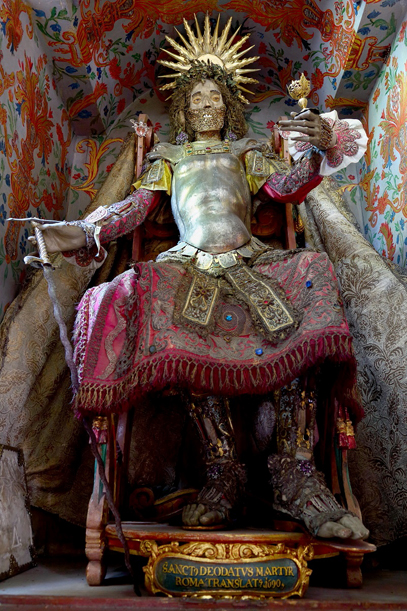
To
create Saint Deodatus in Rheinau, Switzerland, nuns molded a wax face
over the upper half of his skull and fashioned his mouth with a fabric
wrap.
................................
Resurrecting the Dead
On May 31, 1578, local vineyard workers discovered that a hollow along Rome’s Via Salaria, a road traversing the boot of Italy, led to a catacomb. The subterranean chamber proved to be full of countless skeletal remains, presumably dating back to the first three centuries following Christianity’s emergence, when thousands were persecuted for practicing the still-outlawed religion. An estimated 500,000 to 750,000 souls—mostly Christians but including some pagans and Jews—found a final resting place in the sprawling Roman catacombs.
For hundreds of skeletons, however, that resting place would prove anything but final. The Catholic Church quickly learned of the discovery and believed it was a godsend, since many of the skeletons must have belonged to early Christian martyrs. In Northern Europe—especially in Germany, where anti-Catholic sentiment was most fervent—Catholic churches had suffered from plunderers and vandals during the Protestant Revolution over the past several decades. Those churches’ sacred relics had largely been lost or destroyed. The newly discovered holy remains, however, could restock the shelves and restore the morale of those parishes that had been ransacked.
The holy bodies became wildly sought-after treasures. Every Catholic church, no matter how small, wanted to have at least one, if not ten. The skeletons allowed the churches to make a “grandiose statement,” Koudounaris says, and were especially prized in southern Germany, the epicenter of “the battleground against the Protestants.” Wealthy families sought them for their private chapels, and guilds and fraternities would sometimes pool their resources to adopt a martyr, who would become the patron of cloth-makers, for example.
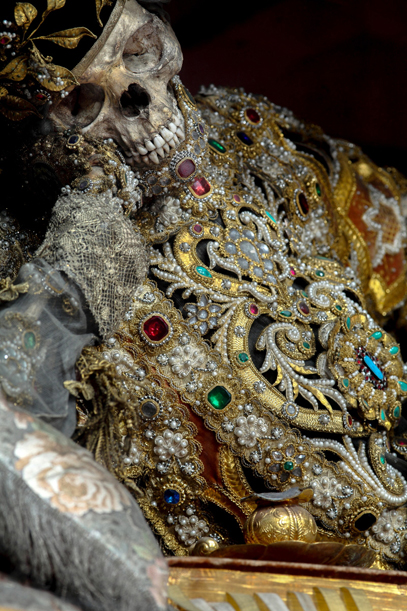
Saint
Valentinus is one of the ten skeletons decorated by the lay brother
Adalbart Eder. Valentinus wears a biretta and an elaborate deacon’s
cassock to show off his ecclesiastical status. Today, he is housed
in Waldsassen Basilica in Germany, along with his nine brethren.
At one point, Koudounaris attempted to estimate in dollar terms how profitable these ventures would have been for the deliverymen, but gave up after realizing that the conversion from extinct currencies to modern ones and the radically different framework for living prevented an accurate translation. “All I can say is that they made enough money to make it worthwhile,” he says.
The Vatican sent out thousands of relics, though it’s difficult to determine exactly how many of those were fully articulated skeletons versus a single shinbone, skull or rib. In Germany, Austria and Switzerland, where the majority of the celebrated remains wound up, the church sent at least 2,000 complete skeletons, Koudounaris estimates.
For the Vatican, the process of ascertaining which of the thousands of skeletons belonged to a martyr was a nebulous one. If they found “M.” engraved next to a corpse, they took it to stand for “martyr,” ignoring the fact that the initial could also stand for “Marcus,” one of the most popular names in ancient Rome. If any vials of dehydrated sediment turned up with the bones, they assumed it must be a martyr’s blood rather than perfume, which the Romans often left on graves in the way we leave flowers today. The Church also believed that the bones of martyrs cast off a golden glow and a faintly sweet smell, and teams of psychics would journey through the corporeal tunnels, slip into a trance and point out skeletons from which they perceived a telling aura. After identifying a skeleton as holy, the Vatican then decided who was who and issued the title of martyr.

Saint Munditia arrived at the Church of Saint Peter in Munich along with a funerary plaque taken from the catacombs.
Each convent would develop its own flare for enshrouding the bones in gold, gems and fine fabrics. The women and men who decorated the skeletons did so anonymously, for the most part. But as Koudounaris studied more and more bodies, he began recognizing the handiwork of particular convents or individuals. “Even if I couldn’t come up with the name of a specific decorator, I could look at certain relics and tie them stylistically to her handiwork,” he says.
Nuns were often renowned for their achievements in clothmaking. They spun fine mesh gauze, which they used to delicately wrap each bone. This prevented dust from settling on the fragile material and created a medium for attaching decorations. Local nobles often donated personal garments, which the nuns would lovingly slip onto the corpse and then cut out peepholes so people could see the bones beneath. Likewise, jewels and gold were often donated or paid for by a private enterprise. To add a personal touch, some sisters slipped their own rings onto a skeleton’s fingers.

Saint
Kelmens arrived in Neuenkirch, Switzerland, in 1823 – decades after the
original wave of catacomb saints were distributed throughout Europe.
Two nuns decorated his bones.
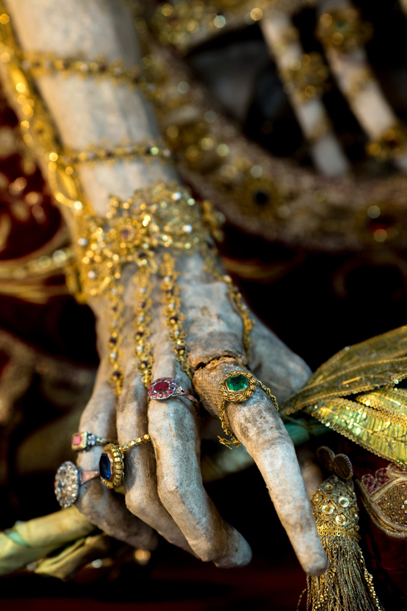
Devoted
patrons often gave their own jewelry to the saints, such as these rings
worn on the gauze-wrapped fingers of Saint Konstantius in Rohrschach,
Switzerland.

Saint
Gratian, another of Adalbart Eder’s Waldassen skeletons. Here, the
saint is decked out in a re-imagining of Roman military attire,
including lace-up sandals and shoulder, chest and arm guards.
Quoting Voltaire, Koudounaris writes that the corpses were seen as reflection of “our ages of barbarity,” appealing only to “the vulgar: feudal lords and their imbecile wives, and their brutish vassals.”

Catacomb
saints were often depicted in a reclining position, as demonstrated
here by Saint Friedrich at the Benedictine abbey in Melk, Austria. He
holds a laurel branch as a sign of victory.
In other cases, leads—which he gathered through traveler’s accounts, parish archives and even Protestant writings about the Catholic “necromancers”—did pan out. He found one skeleton in the back of a parking-garage storage unit in Switzerland. Another had been wrapped in cloth and stuck in a box in a German church, likely untouched for 200 years.
After examining around 250 of these skeletons, Koudounaris concluded, “They’re the finest pieces of art ever created in human bone.”
Though today many of the heavenly bodies suffer from pests burrowing through their bones and dust gathering on their faded silk robes, in Koudounaris’ photos they shine once more, provoking thoughts of the people they once were, the hands that once adorned them and the worshipers who once fell at their feet. But ultimately, they are works of art.
“Whoever they may have been as people, whatever purpose they served rightly or wrongly as items, they are incredible achievements,” he says. “My main objective in writing the book is to present and re-contextualize these things as outstanding works of art.”
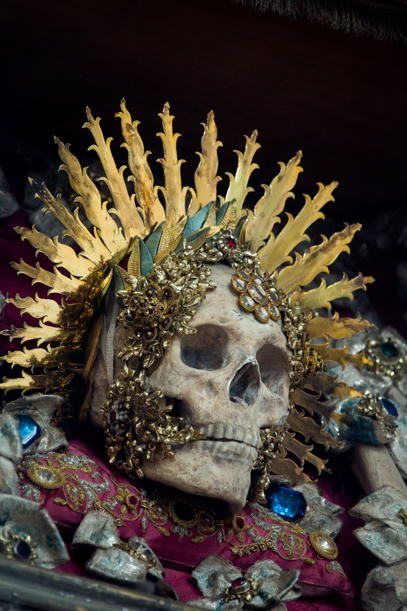
Only
the head of Saint Benedictus – named in honor of Saint Benedict, the
patron of the monastery – arrived in Muri, Switzerland, in 1681.
For Koudounaris, however, it’s not enough to simply document them in a book. He wants to bring the treasures back into the world, and see those in disrepair restored. Some of the church members agreed with Koudounaris’ wish to restore the skeletons, not so much as devotional items but as pieces of local history. The cost of undertaking such a project, however, seems prohibitive. One local parish priest told Koudounaris he had consulted with a restoration specialist, but that the specialist “gave a price so incredibly high that there was no way the church could afford it.”
Still, Koudounaris envisions a permanent museum installation or perhaps a traveling exhibit in which the bones could be judged on their artistic merits. “We live in an age where we’re more in tune with wanting to preserve the past and have a dialogue with the past,” he says. “I think some of them will eventually come out of hiding.”
***

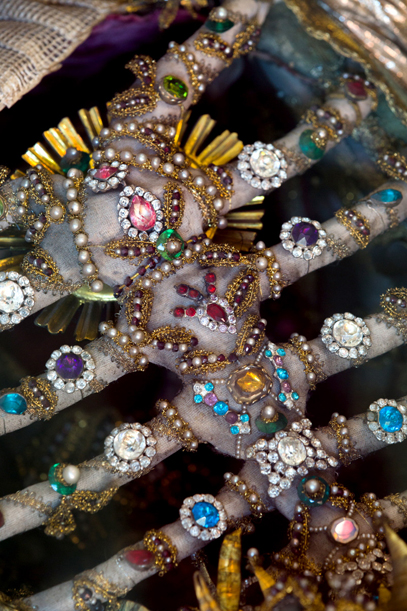
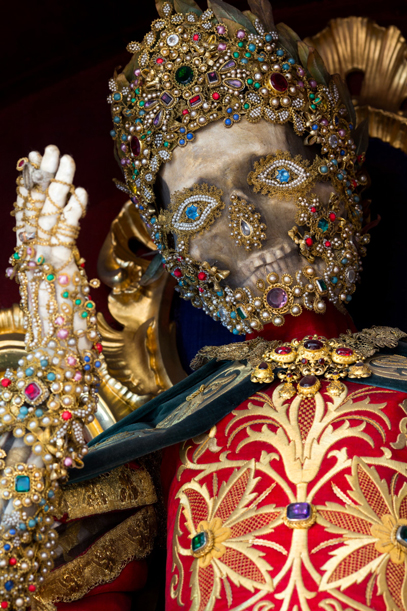
No comments:
Post a Comment